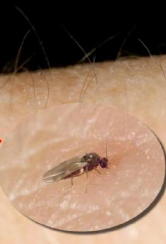CALHOUN DEER BEING TESTED FOR HEMORRHAGIC DISEASE - Legacy Of Winter That Never Was
During past weeks several landowners in the Arnoldsburg area have found dead deer on their property.
Normally, the first thought someone would have when seeing a dead deer is to wonder whether the deer was killed by a car. Unfortunately, some of the local deer that are turning up dead are not dying as a result of vehicle collisions and a disease is now being studied as the potential cause of the mortality.
Late last week the West Virginia DNR tested a dead deer from the Arnoldsburg area for the presence of a very serious disease of white tailed deer called hemorrhagic disease.
 Hemorrhagic disease is caused by a virus that infects deer when they are bitten by small flies called biting midges (no-see-ums) that were extremely abundant earlier this summer, mostly as a result of never having any frigid weather last winter. The disease usually does not appear until a couple months after the deer are bitten with most cases showing up in late summer or early fall.
Hemorrhagic disease is caused by a virus that infects deer when they are bitten by small flies called biting midges (no-see-ums) that were extremely abundant earlier this summer, mostly as a result of never having any frigid weather last winter. The disease usually does not appear until a couple months after the deer are bitten with most cases showing up in late summer or early fall.
Hemorrhagic disease has not been active in West Virginia since 2007. There is no treatment for the disease and the spread of the disease will not stop until we have freezing weather later this fall. Because hemorrhagic disease has not been active in West Virginia for so long, the local deer have no built up immunity or resistance to the disease and the potential for noticeable mortality is high.
If the tests on the deer from the Arnoldsburg area confirm hemorrhagic disease the West Virginia DNR will make an official announcement that will include additional options for reporting suspected cases.
(WVDNR is now conducting evaluation of disease) Local property owners concerned whether dead deer on their land have hemorrhagic disease or died from some other cause are encouraged to contact Jeff McCrady at the WV DNR in Parkersburg at 304-420-4550. For disease sampling purposes deer that are as freshly dead as possible are preferred and information on sites where two or more deer are extremely sick or recently dead are of special interest to DNR biologists.
Hemorrhagic disease is not contagious to humans.
A publication that describes hemorrhagic disease in great detail is available online at www.vet.uga.edu